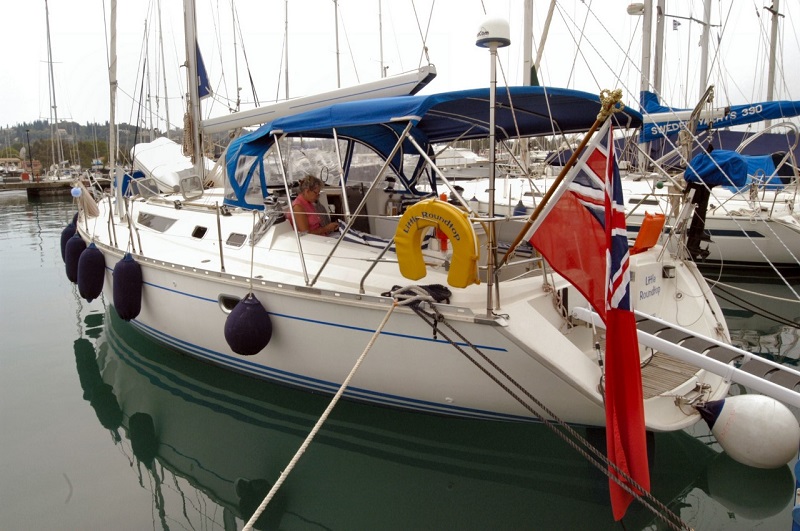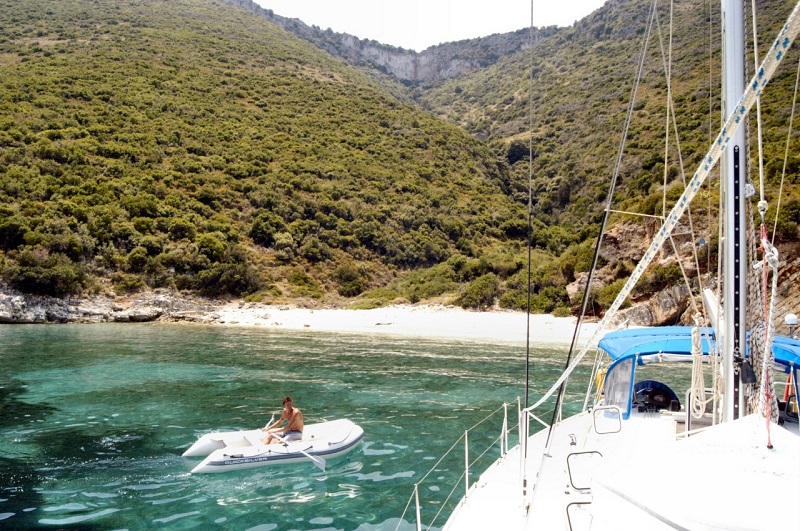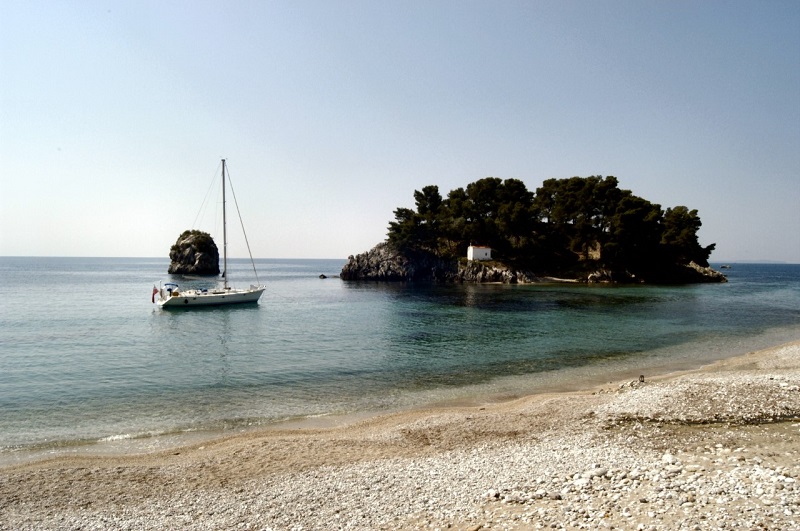
How is it living aboard a yacht in Greece? British expatriates Tony and Tessa Cross have spent years doing it while crisscrossing the Aegean.
By Tony Cross
If you walk along the quay of almost any coastal town in Greece you’ll likely find a number of sailing yachts moored there. Most of them are probably owned by locals and are used infrequently, but one or two will be live-aboards; yachts that are used as a home.
Some live-aboard yachts are used only during the summer months, their owners going back to their home country for the winter, but many will be the main full-time home for their owners, as our yacht was for us.
Most live-aboards are retired, enjoying the freedom and independence of sailing whenever and wherever they like. Increasingly these days however, some are middle-aged and taking a few years out of their busy working lives to live a calmer, less hectic, lifestyle for a while.
Live-aboard myths
It’s a common myth that you have to be rich to live-aboard a sailing yacht. Whilst it’s true that a yacht is an expensive luxury when bought in addition to a home, a yacht that is bought as a home can be considerably less expensive to buy than most houses and apartments.
Most of the live-aboards that we met in our twelve years of living aboard our sailing yacht Little Roundtop were not rich, they were just ordinary people like us, who had sold their house or apartment and chosen to live aboard a yacht instead.
Another myth about the live-aboard life is that you need to have been sailing since you were a child in order to be safe aboard your own yacht. It’s true that most live-aboards have been sailing for much of their adult lives, that’s partly why they have chosen to live aboard a yacht in the first place, but sailing is not rocket science and anybody can learn to do it.
As an example, we learned to sail very late in life so that we could retire aboard our own yacht. We first set foot aboard a sailing yacht less than five years before we bought our own boat and set off. If we can do it then anyone can do it.

A game of two halves
Living aboard a sailing yacht in Greece is a bit like like football; it’s a game of two halves.
In the summer months you’ll be out sailing around, anchoring in remote bays, mooring to the quay of small towns, and generally enjoying the freedom to go or stay pretty much where you like.
In holiday brochures you’ll see pictures of a yacht at anchor in crystal clear waters off a deserted sandy beach with people swimming, or in the evening with people sitting in the cockpit, champagne in hand, watching a blood-red sun slowly sink below the horizon. That’s not a fantasy, that’s exactly what it’s like to live aboard your own yacht in Greece in the summer.
Opportunity to explore thousands of islands with a yacht in Greece
If you seek solitude and independence you have over 6,000 Greek islands to explore, only around 250 of them are inhabited. On the other hand, if you like the company of others, there are many popular anchorages and ports, where you can enjoy meeting new people and making new friends at every stop.
It is possible to continue sailing in the winter months in Greece and some do, but the weather is colder, stormier and less predictable in the winter and most of the smaller coastal towns have shut down.
Most live-aboards head for a marina for the winter; some leave their boats there and head home, but a good many live a more social, organized, and more land-based life in the marina. Drinks and dinner aboard each other’s yachts, barbecues, quiz nights, music groups, walking groups, and group meals out are very common during winter in almost any live-aboard marina.
Winter is also a time to do the necessary maintenance on your yacht. Things break more often on a yacht simply because the marine environment is so harsh. Checking all your systems over winter and making any necessary minor repairs is the way to prevent a catastrophic failure that ruins your summer and makes a big hole in your pocket.
That doesn’t mean you have to be an expert at boat maintenance however, sailors love to help one other. In almost any winter marina you’ll find electricians, diesel engineers, computer wizards and the like who can help you sort out whatever problems you might have.
In our first summer of sailing for example, our alternator failed whilst we were motoring at sea. I had it out in bits on the cockpit table at the next port and found that worn brushes was the problem. Unfortunately the small town we were in had nowhere where I could buy new ones. As I was scratching my head wondering what we were going to do, the guy on the boat next door asked what the problem was. He popped down below, returned with a small box and after some rummaging around produced two half-worn brushes of exactly the right size. He even came over to help me put it all back together!

Water, electricity, and the smelly stuff
There are three main differences between life aboard a yacht and life ashore; access to fresh water, access to electricity, and access to sewage facilities. On a yacht you’re not connected permanently to any of those services, except when you’re in a marina of course.
All yachts carry fresh water in large tanks on board, and many supplement this by storing water in bottles or containers in the bilges (the space between the cabin floor and the hull). A constant concern is where you’ll be able to fill up and when you’ll need to fill up. On Little Roundtop for example, we could make our water supply last about two weeks if we were really careful in how we used it.
A sailing yacht uses a bank of several large deep-cycle batteries to power everything on board; the cabin lights, the navigation instruments, the fridge, the television, your computers, phones – everything. The power drain on a live-aboard yacht often means that the batteries need to be recharged daily.
If you can connect to mains electricity ashore then your battery charger will handle the recharge comfortably overnight. At sea however, you’ll be relying on the engine alternator, possibly a generator if the boat has one, or more commonly these days, solar panels. On Little Roundtop our large solar panel array meant that we were fully electrically independent in the sunny summer months.
The biggest (and nastiest) problem on a yacht is your raw sewage. It is illegal in Greece (and almost everywhere else) to discharge raw sewage into the sea within three nautical miles of the shore. The penalties if you’re caught are severe, and rightly so.
That means that you need a holding tank in which to store your raw sewage until you find somewhere to pump it out ashore, or until you’re at least three nautical miles offshore when you can legally discharge it. It’s clearly very important that you keep a close check on how much capacity remains in your holding tank!

Living room
Space is at a premium on any sailing yacht of course, but it’s surprising how quickly you adapt to living in the space that’s available. That said, if you ask any sailor what the ideal live-aboard yacht length is he’ll tell you that it’s two metres longer than the one he has!
Most yachts have two or three double cabins, though standing room in these is usually limited and sometime non-existent. If you sit up suddenly in bed you’ll likely bang your head on the ceiling.
The main saloon on most yachts has standing room everywhere, usually with a fixed table and seating for six to eight people. This is also where you’ll find the galley, typically with a gimballed gas hob and oven, a sink, and a refrigerator.
What is lacking in all sailing yachts is hanging space for clothes. There is plenty of storage space on a yacht, but it’s usually on shelves in cupboards, in lockers under seat cushions or behind seat backs. It’s quite common to have to remove a stack of other clothes to get to whatever you want.
Most people who have never been on a yacht always want to know about the toilet facilities. They’re known as ‘the heads’ on a yacht and are flushed with seawater via a manual pump, either direct into the sea or into the holding tank depending on what was in the bowl. There is usually a small hand basin in there as well and they typically double-up as a shower cubicle too.

The downsides of living aboard yacht
It isn’t all sunshine, calm seas and deserted anchorages though. In a sailing yacht you’re dependent on the wind to get you where you want to go. That usually means waiting around in port or at anchor for the winds to become favorable for the direction in which you want to go. Either that or you use your diesel engine and chug along noisily against the wind.
There is a fine line between waiting for strong winds to allow you to sail fast and avoiding the challenge of the big seas that strong winds whip up – especially in Greece and the Mediterranean.
We made the classic mistake one year of thinking we could reach the next port from the safe anchorage we were at in Greece before a forecast gale force 8 arrived. Racing the weather is never a good idea and it taught us a hard and valuable lesson.
We set off in strengthening force 5 winds and a half metre swell coming from astern, conditions which are quite manageable, even fun. Unfortunately the winds strengthened much faster over the next few hours than the forecast had suggested. As we rounded a headland just before our intended destination the wind was already blowing at gale force 8 and the following seas were approaching four metres high.
Large following seas are very dangerous in a sailing yacht, if the rudder loses its grip on the sea as a wave passes underneath the yacht will suddenly ‘broach’ and turn beam-on to the waves. That would likely have resulted in a capsize in those kind of seas. It was a very frightening situation to be in.
Sailors often say that it’s better to be in port wishing you were at sea, than to be at sea wishing you were in port. That saying had never been more true than it was for us at that time.
We had no business being out there in those conditions, but we learned from our mistake and we never attempted to race the weather again.

Getting started to live aboard yacht
Whilst it’s true that anyone can learn to sail, the live-aboard life is not for everyone. The only way to find out of course is to give it a try. If you think it might be for you and you don’t know one end of a yacht from the other (like we didn’t at first) then join a local sailing club and learn to sail. You’ll soon find out whether the sailing life suits you and you’ll meet a whole bunch of people who can help and guide you when (and if) the time comes to buy your own boat and try the live aboard life for yourself.
Twenty years from now, you will be more disappointed by the things you didn’t do than those you did. So throw off the bowlines. Sail away from safe harbor. Catch the wind in your sails. Explore. Dream. Discover. – Mark Twain.
See all the latest news from Greece and the world at Greekreporter.com. Contact our newsroom to report an update or send your story, photos and videos. Follow GR on Google News and subscribe here to our daily email!



